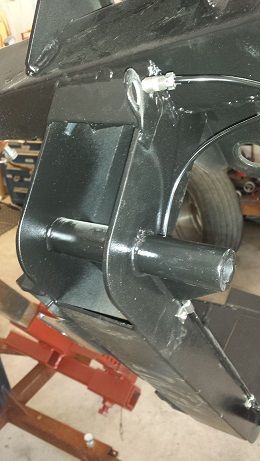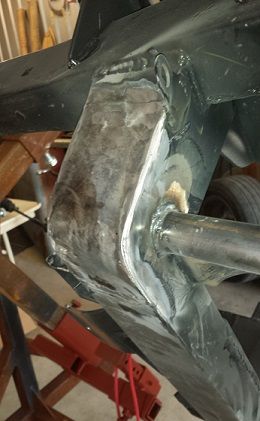Thread: MS II front end cross memeber
-
04-29-2015 06:06 PM #1
MS II front end cross memeber
Having read some stories about MS II front ends being weak and breaking along the welds and other places I have a question for users of MS II after market front ends.
Are seeing any problems with yours and are they similar to this one pictured ?
2nd I'm thinking of boxing in the open area to add strength, any thoughts on that ?
thanks for the inputs.

-
Advertising

- Google Adsense
- REGISTERED USERS DO NOT SEE THIS AD
-
04-30-2015 03:12 AM #2
I have a Fatman front stub on my 50 Ply wagon. It has the MS2 dropped spindles and tubular A-arms w/coilovers. It rides like a new car and I haven't had any problems with it.
IMO..........alot depends on who's stuff you buy. I will always stick with a brand name when it comes to anything structural like chassis parts. I also do my homework and check with other friends who use chassis parts from all the different manufacturers.
-
04-30-2015 05:26 AM #3
Navy, I have no experience with them, but I think that a well formed boxing plate to close in that area can't hurt.Roger
Enjoy the little things in life, and you may look back one day and realize that they were really the BIG things.
-
04-30-2015 07:04 AM #4
The inter-web is a wonderful place, but can also be populated with an abundance of trolls who deal in speculation/rumor/outright falsehoods. Sorting real experience from opinion can be tough, even when folks claim to have "experience". That being said, MII front end kits are similar to '32 glass bodies, lots of sketchy people got into the "business" of selling the stuff when the market was really hot a few years back. Odds are there are some crap parts out there built down to a price instead of up to a quality standard. As Tom said, a name brand product with a long history is a safer bet. Add to that the questions of who installed it, what their skill level is, and even do they know how to weld properly? Further the arguments over the years about whether a "Pinto" based suspension was heavy duty enough for application X. First the Pinto/MII was heavier than many think, some versions near mid 3000# range, and that was with all of the engine weight centered over the suspension rather than mostly behind it as in most rod applications. And then there's the matter of what gauge material was used in the fab of the aftermarket pieces. Lots of variables to consider.
I've been a Heidt's fan for years because their stuff is proven and looks good to boot. They've worked for me, not interested in any other brand. Others have demonstrated their products are well made, I just don't see a reason to deviate from a known, successful product.
As for the setup you pictured, there probably isn't much useable strength to be gained from capping that hole, but as Roger said, what can it hurt? If nothing else you would eliminate a cavity that will catch all manner of road debrisYour Uncle Bob, Senior Geezer Curmudgeon
It's much easier to promise someone a "free" ride on the wagon than to urge them to pull it.
Luck occurs when preparation and opportunity converge.
-
04-30-2015 09:31 AM #5
The MII was a well-designed IFS if you built it with the strut rod that is was designed to use, but some of the fellows who were apparently more interested in making a buck than they were turning out well-designed systems, decided to eliminate the rod and make up their own lower arm designs. In my opinion, that's where the trouble started. In most of the systems I have seen, there is insufficient support front to rear because of the narrow attachment of the lower arm to the crossmember/frame. And again, in my opinion, if you lack a degree in mechanical engineering, you have no business building independent front suspension systems. Used like the factory engineers designed it, there should be no problems.
.Last edited by techinspector1; 04-30-2015 at 09:34 AM.
PLANET EARTH, INSANE ASYLUM FOR THE UNIVERSE.
-
04-30-2015 01:04 PM #6
I used a Progressive Automotive crossmember back in the early 80's when I built this all-steel A-bone tudor. Note that I did use the original strut rods. The only modification I made was to fabricate tubular upper-control arms and narrow the installation 1" to fit under the Model A fenders. Back then, this was fairly new technology, and I was concerned with the strength of using both upper AND and lower A-arms. I wasn't 100% thrilled with the look of it, but with full fenders, it really didn't show that much.
This A-bone had a 454 Chevy, Toploader 4-speed and 4:10 gears. I had no trouble running mid to low 12's with it, the geometry aligned perfectly and it ran straight as a die on both the strip and the highway.
All that being said, I wouldn't hesitate to use a Heidt's or Pete and Jake's M-II clone IFS.
30-5.jpg
a-arm2.jpgJack
Gone to Texas
-
04-30-2015 05:37 PM #7
As Tech said the factory ones didn't have problems. The backyard engineers will get you killed. They came with bracing and its because it is needed. Never had any problems with themCharlie
Lovin' what I do and doing what I love
Some guys can fix broken NO ONE can fix STUPID
W8AMR
http://fishertrains94.webs.com/
Christian in training
-
05-05-2015 06:52 PM #8
-
05-06-2015 02:46 AM #9
That end cap came out great. Can't barely see the joint. Good work.
-
05-06-2015 04:38 AM #10
The boxing plate may or may not be "necessary", but it's sure a lot cleaner than it was without the plate. Well done!Roger
Enjoy the little things in life, and you may look back one day and realize that they were really the BIG things.
-
05-12-2015 05:59 PM #11
Thanks for the inputs guys !
-
05-13-2015 07:21 AM #12
You most definitely didn't hurt it. And it does look nice. The added plate gives it a much nicer finished look. Great job!
-
05-13-2015 08:39 AM #13
i have replaced 3 mll cross members because of fatigue cracks. fatmans wont do this because it is heavy wall tubing . the others are made from 1/8 flat welded together . i do not trust them nor will i install another one.
-
05-13-2015 06:06 PM #14
Put in 4 or so, no problems but they all have been boxed where yours was not, one big problem mentioned on another forum from a expert was that there is no 4000 Mustang II's, and we tend to put these on heavier cars than the original design which could be beefed up a little. With that being said and many using strutless lower a arms. and then the back spacer isn't supported and fatigues the integrity of the crossmember. The solution is to add a bracket and put the through bolt in double shear on the lower pivot. On my latest car I did this because the weight of the hemi I put in, made me feel a little better when I hit a large bump, the picture is off another site and nothing I have done but you can see the bracket going from the frame to the back of the bolt, pretty easy to do and extra safety. Best of Luck Matthyj
1960StudebakerHawk005-1.jpgWhy is mine so big and yours so small, Chrysler FirePower
-
05-14-2015 06:16 AM #15
As Tech and Shine mentioned, the aftermarket manufactures moved away from the Ford control arm and strut rod design that used larger and more flexible bushing materials and now have issues with stress cracks in the crossmember using the small control arm bushings that are very rigid. This transfers more of the impact to the crossmember and brackets, causing the fatigue and cracking issues. Some manufacturers have better designs than others, but all may eventually crack out depending a great deal on road conditions and miles driven. 1/4" wall crossmembers welded to 1/8" wall frame rail; where is the crack going to start? Just a thought.Last edited by Deuce4dad; 05-14-2015 at 06:21 AM.




 11Likes
11Likes

 LinkBack URL
LinkBack URL About LinkBacks
About LinkBacks Reply With Quote
Reply With Quote


Friday and Saturday (4/11 & 12/25) Chris (my wife) and I made the journey to Homestead-Miami Speedway so I could participate in the Florida Power & Light sponsored Electrathon event.:cool: It was...
Electrathon - A Different Kind of...